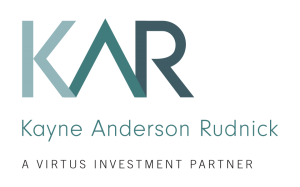Virtus KAR Small-Cap Value Series
Virtus KAR Small-Cap Value Series
Investment Overview
The Series seeks to generate attractive risk-adjusted long-term returns by investing in the stocks of U.S. small-cap value companies with durable competitive advantages, excellent management, lower financial risk, and strong growth trajectories. A disciplined investment process is employed to identify businesses that are differentiated by above-average returns on capital and trading at attractive valuations.
Investment Partner
Kayne Anderson Rudnick Investment Management, LLC
Founded in 1984, Kayne Anderson Rudnick (KAR) manages quality-focused equity strategies across investment styles, market caps, and geographies. KAR believes that strong risk-adjusted returns may be achieved through investment in high-quality companies with market dominance, excellent management, financial strength, and consistent growth, purchased at reasonable prices.
Learn more about Kayne Anderson Rudnick Investment Management, LLC
Investment Professionals

Julie Kutasov
Portfolio Manager and Senior Research Analyst
Industry start date: 2001
Start date as fund Portfolio Manager: 2010

Craig Stone
Co-Chief Investment Officer, Portfolio Manager and Senior Research Analyst
Industry start date: 1989
Start date as fund Portfolio Manager: 2010
Key Features
High-Quality Businesses
Searches for quality small-cap value companies with solid balance sheets, consistent growth, profitability, and market dominant business models
Lower Volatility Approach
Extensive fundamental research favors companies with less business risk, as defined by lower earnings variability, consistent and profitable growth, high returns on capital, strong free cash flow, and a low organic need for external financing, all of which can help to protect profits in difficult markets
High-Conviction Portfolio
Focused on the portfolio team's 25-35 strongest investment opportunities, with a long-term, low-turnover approach to realize full stock value potential
Characteristics4
(as of 06/28/2024)| Average Weighted Market Cap (billions) | $5.38 |
| Median Market Cap (billions) | $4.12 |
| Trailing P/E Ex-Negative Earnings | 22.75 |
| Price-to-Cash Flow | 17.80 |
| Price-to-Book Value | 2.93 |
| 3-Year Earnings Growth Rate | -3.84 |
Top Holdings (% Series)
| Security | |
|---|---|
| Houlihan Lokey Inc | |
| Watsco Inc | |
| Primerica Inc | |
| RBC Bearings Inc | |
| Construction Partners Inc | |
| Armstrong World Industries Inc | |
| Thor Industries Inc | |
| Hillman Solutions Corp | |
| Landstar System Inc | |
| HB Fuller Co |
Holdings are subject to change.
Sector Allocation (% Equity)
| Industrials | |
| Financials | |
| Consumer Discretionary | |
| Consumer Staples | |
| Materials | |
| Health Care | |
| Real Estate | |
| Information Technology |
Growth of $10,000 Investment
From toPerformance
Performance data quoted represents past results. Past performance is no guarantee of future results and current performance may be higher or lower than the performance shown. Investment return and principal value will fluctuate, so your shares, when redeemed, may be worth more or less than their original cost.
Returns for periods of less than one year are cumulative total returns.
Sales Charge and Expenses
The Index shown represents the Fund's performance index, which may differ from the Fund's regulatory index included in the Fund's Prospectus.
Distribution History2
| Ex-Date | |
| Income | |
| STCG | |
| LTCG | |
| Reinvest NAV |
Risk Statistics3
(as of )| Fund | Index | |
|---|---|---|
| R2 | ||
| Beta | ||
| Alpha | ||
| Std Dev |
Risk Considerations
Financial Materials
The investments for the Virtus Variable Insurance Funds (the “Funds”) are managed by the same portfolio manager(s) who manage one or more other funds that have similar names, investment objectives, and investment styles as the Funds. You should be aware that the Funds are likely to differ from the other mutual funds in size, cash flow pattern, and tax matters. Accordingly, the holdings and performance of the Funds can be expected to vary from those of the other mutual funds.
Shares of the Funds are sold only through the currently effective prospectuses and are not available to the general public. Shares of the Funds may be purchased only by life insurance companies to be used with their separate accounts which fund variable annuity and variable life insurance policies or qualified retirement plans and are also available as an underlying investment fund for certain qualified retirement plans. The performance information for the Funds does not reflect fees and expenses of the insurance companies. If such fees and expenses were deducted, performance would be lower.
Please carefully consider the investment objectives, risks, charges, and expenses of the Virtus Variable Insurance Funds before investing. For this and other information about any Virtus Variable Insurance Fund, call 1-800-367-5877 or visit Virtus.com for a prospectus and/or summary prospectus. Read it carefully before you invest or send money.
Morningstar Disclosures:
The Morningstar Rating™ for funds, or "star rating", is calculated for managed products (including mutual funds, variable annuity and variable life subaccounts, exchange-traded funds, closed-end funds, and separate accounts) with at least a three-year history. Exchange-traded funds and open-ended mutual funds are considered a single population for comparative purposes. It is calculated based on a Morningstar Risk-Adjusted Return measure that accounts for variation in a managed product's monthly excess performance, placing more emphasis on downward variations and rewarding consistent performance. The top 10% of products in each product category receive 5 stars, the next 22.5% receive 4 stars, the next 35% receive 3 stars, the next 22.5% receive 2 stars, and the bottom 10% receive 1 star. The Overall Morningstar Rating for a managed product is derived from a weighted average of the performance figures associated with its three-, five-, and 10-year (if applicable) Morningstar Rating metrics. The weights
© 2023 Morningstar, Inc. All rights reserved. The information contained herein: (1) is proprietary to Morningstar and/or its content providers; (2) may not be copied or distributed; and (3) is not warranted to be accurate, complete, or timely. Neither Morningstar nor its content providers are responsible for any damages or losses arising from any use of this information. Past performance is no guarantee of future results.
1 Yields/Distributions: Distribution Yield (at NAV) is calculated by annualizing the latest month's distribution and dividing by the NAV on the last business day of the period. SEC Yield represents the net investment income earned by a fund over a 30-day period (7-day period for Money Market Funds), expressed as an annual percentage rate based on the fund's public offering share price at the end of the 30-day period (7-day period for Money Market Funds).
2 Distribution History: Distributions are represented on a cash basis and may be reclassified at year end for tax purposes. The Fund will send you a Form 1099-DIV for the calendar year that will tell you how to report these distributions for federal income tax purposes. STCG: Short Term Capital Gain, LTCG: Long Term Capital Gain
3 Risk Statistics: R2 is a statistical measure that represents the percentage of a fund or security's movements that can be explained by movements in a benchmark index. Beta is a quantitative measure of the volatility of a given portfolio to the overall market. Alpha is a risk adjusted measure of an investment's excess return relative to a benchmark. A positive Alpha indicates that the investment produced a return greater than expected for the risk (as measured by Beta) taken. Standard Deviation measures variability of returns around the average return for an investment fund. Higher standard deviation suggests greater risk. Risk Statistics are calculated using 36 monthly returns.
4 Characteristics: For Equity Funds: Avg. Weighted Market Cap (bn): The sum of each security's weight within the fund (or index) multiplied by the security's market capitalization. Trailing P/E-Negative Earnings: Per-share stock price divided by the latest 12-months Earnings per Share; Price/Cash Flow: Per-share stock price divided by the per-share operating cash flow; Price/Book: Per-share stock price divided by the latest 12-month per-share Book Value; 3-Year EPS Growth Rate: Average of earnings per share growth for latest 3-year period. The 3-Year EPS Growth Rate is not a forecast of the fund's performance.
4 Characteristics: For Fixed Income Funds: Effective Duration represents the interest rate sensitivity of a fixed income fund. For example, if a fund's effective duration is five years, a 1% increase in interest rates would result in a 5% decline in the fund's price. Similarly, a 1% decline in interest rates would result in a 5% gain in the fund's price.
Not insured by FDIC/NCUSIF or any federal government agency. No bank guarantee. Not a deposit. May lose value.
